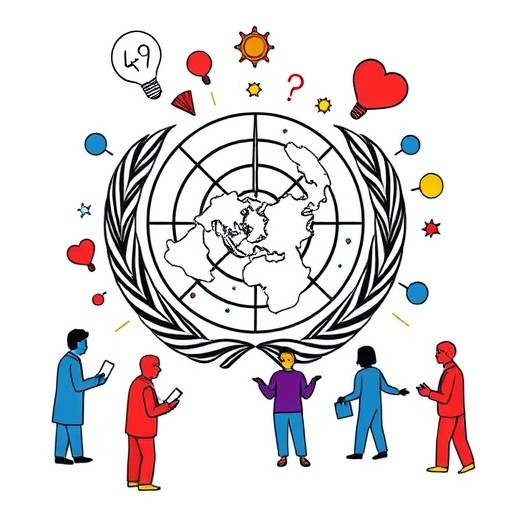In the evolving landscape of global health communication, the imperative for humility has emerged as a cornerstone for effective dissemination of scientific findings. This necessity is sharply illustrated by the United Nations’ recent report on child mortality estimates, which has sparked intense debate and scrutiny within the scientific community and beyond. The discourse surrounding this report highlights the complexities and pitfalls of communicating scientific data that have profound humanitarian implications.
Scientific communication is often perceived as a straightforward relay of facts from experts to the public. However, the UN’s latest child mortality report unveils the nuanced challenges embedded in this process. Methodologies that are inherently probabilistic and subject to variability must be conveyed with precision, yet without overstating certainty. Failure to acknowledge these nuances risks eroding public trust and potentially hindering policy responses aimed at saving lives.
At the heart of the discussion lies the contrast between the certainty often expected by the public and policymakers versus the inherent uncertainties in statistical modeling. Child mortality estimates, derived from demographic surveys, censuses, and vital registration systems, rely heavily on sophisticated analytical techniques. These methods must integrate incomplete, noisy, and sometimes contradictory data streams, demanding cautious interpretation and communication.
This context underscores why humility—defined here as an acknowledgment of the limits of present understanding—is critical in scientific communication. By openly recognizing uncertainties and the provisional nature of findings, researchers can foster a more informed public dialogue. Such transparency is essential in bolstering confidence and support for health interventions, which ultimately depend on the credibility of the evidence base.
The UN report’s release was accompanied by headlines proclaiming dramatically shifting child mortality figures, prompting institutional responses ranging from endorsement to skepticism. This polarized reception underscores the importance of framing scientific information in ways that highlight both the strengths and constraints of analytic approaches, rather than presenting results as definitive truths.
Moreover, the iterative nature of scientific progress further complicates messaging. Child mortality estimates have historically been refined as new data and improved methodologies become available. Communicating this evolutionary process requires a delicate balance between providing actionable information and maintaining openness to revision, necessitating a nuanced narrative seldom embraced in typical media coverage.
Technical readers familiar with demographic techniques recognize that uncertainty intervals and sensitivity analyses are standard components of responsible reporting. However, these statistical caveats often get lost or oversimplified in mass communication channels, undermining the original intentions of transparency. This gap between scientific complexity and public consumption highlights the necessity for specialized communicators who can bridge these worlds without compromising accuracy.
Furthermore, the political and social ramifications of child mortality statistics intensify the stakes of communication. Numbers influence funding priorities, program implementations, and global health agendas. Misinterpretation or overconfidence in estimates can lead to misallocated resources or diminished urgency, underscoring the ethical responsibility borne by scientists and institutions to communicate with clarity and caution.
In exploring successful communication strategies, the article advocates for embedding humility in messaging protocols. This involves explicitly discussing the limitations of data collection methods, the assumptions underlying analytical models, and the range of plausible outcomes. Such openness not only respects the intelligence of the audience but also prepares stakeholders for future data-driven adjustments.
The role of interdisciplinary collaboration is emphasized as well. Statisticians, epidemiologists, communication experts, and policymakers must coalesce to craft narratives that honor scientific rigor while remaining accessible. This collaborative approach can mitigate the oversimplification that often compromises public understanding and policy effectiveness.
Beyond immediate communication concerns, this emphasis on humility reinforces foundational scientific principles. Science is inherently provisional, continuously self-correcting in light of new evidence. Promoting this ethos publicly counters the misconception of scientific knowledge as static, fostering resilience against misinformation and skepticism.
The UN’s report, therefore, serves as a case study in the perils and potentials of contemporary science communication. It compels a reevaluation of how complex statistical evidence is shared and received, particularly when lives and societal well-being are at stake. The broader health research community stands to gain by adopting humility not as a weakness but as a strategic virtue.
In conclusion, the dialogue stimulated by the UN’s child mortality estimates underscores the transformative power of humility in science communication. By embracing uncertainty and complexity transparently, scientists can enhance the credibility and impact of their work. This approach promises not only to improve public understanding but also to strengthen the foundation for global health actions informed by the best available evidence.
As scientific endeavors continue to grapple with the challenges of conveying complicated data in an era of instant information, the lessons from this report provide a guiding framework. Honesty about limitations, clarity in explanation, and a commitment to ongoing dialogue are essential for fostering trust and facilitating meaningful change.
The implications extend far beyond child mortality statistics to the broader realm of data-driven policy and public health discourse. If embraced widely, humility could transform science communication into a more effective tool for societal progress, ensuring that scientific truths retain their value amid the noise of competing narratives.
This paradigm shift toward humility does not diminish scientific authority but rather enhances it by aligning expectation with reality. In doing so, it offers a beacon for future communication strategies seeking to navigate the complexities of modern global health challenges.
Subject of Research: Science communication and the role of humility in interpreting and disseminating child mortality estimates from the United Nations report.
Article Title: Humility is critical in science communication: lessons from the UN’s recent report on child mortality estimates.
Article References:
Reidpath, D.D., Wahl, B. & Schwalbe, N. Humility is critical in science communication: lessons from the UN’s recent report on child mortality estimates. glob health res policy 10, 58 (2025). https://doi.org/10.1186/s41256-025-00444-8
Image Credits: AI Generated




